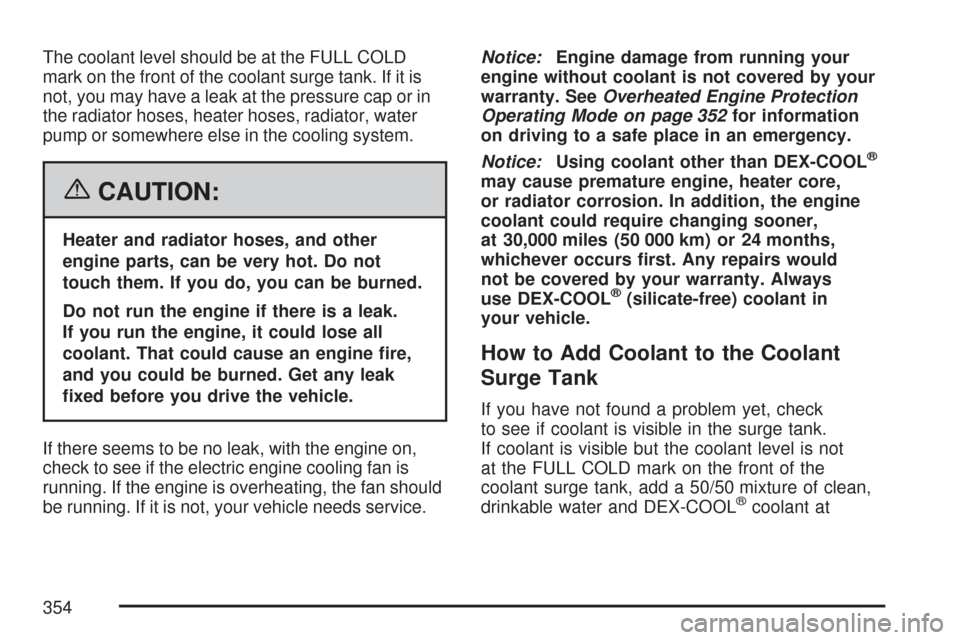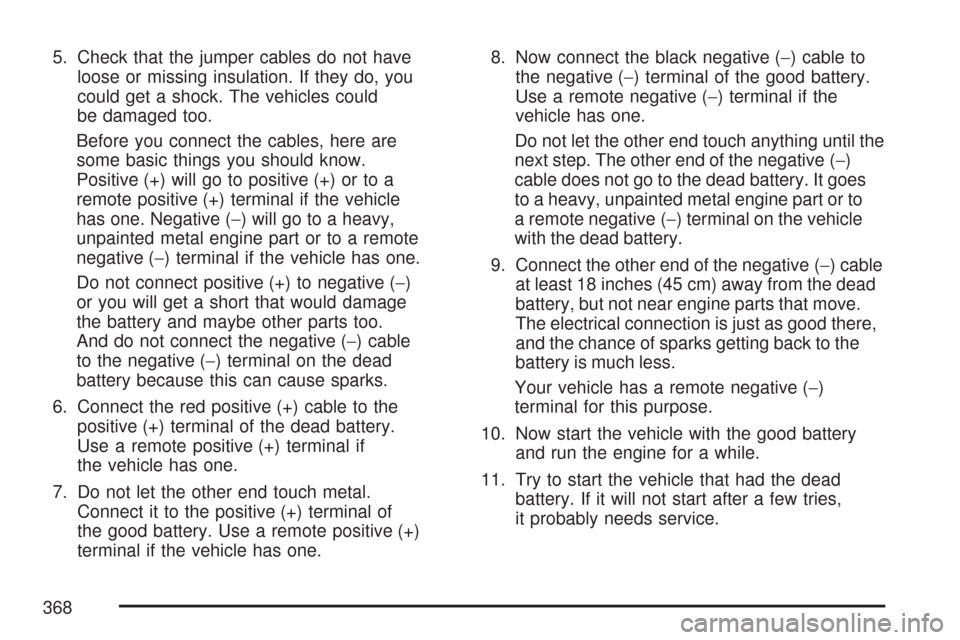Page 354 of 488

The coolant level should be at the FULL COLD
mark on the front of the coolant surge tank. If it is
not, you may have a leak at the pressure cap or in
the radiator hoses, heater hoses, radiator, water
pump or somewhere else in the cooling system.
{CAUTION:
Heater and radiator hoses, and other
engine parts, can be very hot. Do not
touch them. If you do, you can be burned.
Do not run the engine if there is a leak.
If you run the engine, it could lose all
coolant. That could cause an engine �re,
and you could be burned. Get any leak
�xed before you drive the vehicle.
If there seems to be no leak, with the engine on,
check to see if the electric engine cooling fan is
running. If the engine is overheating, the fan should
be running. If it is not, your vehicle needs service.Notice:Engine damage from running your
engine without coolant is not covered by your
warranty. SeeOverheated Engine Protection
Operating Mode on page 352for information
on driving to a safe place in an emergency.
Notice:Using coolant other than DEX-COOL
®
may cause premature engine, heater core,
or radiator corrosion. In addition, the engine
coolant could require changing sooner,
at 30,000 miles (50 000 km) or 24 months,
whichever occurs �rst. Any repairs would
not be covered by your warranty. Always
use DEX-COOL
®(silicate-free) coolant in
your vehicle.
How to Add Coolant to the Coolant
Surge Tank
If you have not found a problem yet, check
to see if coolant is visible in the surge tank.
If coolant is visible but the coolant level is not
at the FULL COLD mark on the front of the
coolant surge tank, add a 50/50 mixture of clean,
drinkable water and DEX-COOL
®coolant at
354
Page 358 of 488
5. Then replace the pressure cap. Be sure the
pressure cap is hand-tight and fully seated.
Check the level in the surge tank when
the system has cooled down. If the coolant
is not at the proper level, repeat Steps 1
through 4, then reinstall the pressure cap.
If the coolant is not at the proper level when
the system cools down again, see your dealer.Power Steering Fluid
SeeEngine
Compartment Overview
on page 330for
reservoir location.
When to Check Power Steering Fluid
It is not necessary to regularly check power
steering �uid unless you suspect there is a leak
in the system or you hear an unusual noise.
A �uid loss in this system could indicate a problem.
Have the system inspected and repaired.
358
Page 359 of 488
How to Check Power Steering Fluid
To check the power steering �uid, do the following:
1. Turn the ignition off and let the engine
compartment cool down.
2. Wipe the cap and the top of the reservoir clean.
3. Unscrew the cap and wipe the dipstick with
a clean rag.
4. Replace the cap and completely tighten it.
5. Remove the cap again and look at the
�uid level on the dipstick. There are markings
on both sides of the dipstick.
The level should be at the FULL COLD mark.
If necessary, add only enough �uid to bring
the level up to the mark.When the engine
compartment is hot,
the level should
be at the HOT mark.
When the engine
compartment is
cool, the level
should be at the
FULL COLD mark.
What to Use
To determine what kind of �uid to use, see
Recommended Fluids and Lubricants on page 443.
Always use the proper �uid. Failure to use the
proper �uid can cause leaks and damage
hoses and seals.
359
Page 361 of 488

Brakes
Brake Fluid
The brake master
cylinder reservoir is
�lled with DOT-3 brake
�uid. SeeEngine
Compartment Overview
on page 330for the
location of the reservoir.
There are only two reasons why the brake �uid
level in the reservoir might go down. The �rst
is that the brake �uid goes down to an acceptable
level during normal brake lining wear. When
new linings are put in, the �uid level goes back
up. The other reason is that �uid is leaking out of
the brake system. If it is, you should have the
brake system �xed, since a leak means that
sooner or later the brakes will not work well.So, it is not a good idea to top off the brake
�uid. Adding brake �uid will not correct a leak.
If you add �uid when the linings are worn,
then you will have too much �uid when you get
new brake linings. You should add or remove
brake �uid, as necessary, only when work is
done on the brake hydraulic system.
{CAUTION:
If you have too much brake �uid, it can
spill on the engine. The �uid will burn if
the engine is hot enough. You or others
could be burned, and your vehicle could
be damaged. Add brake �uid only when
work is done on the brake hydraulic
system. See “Checking Brake Fluid” in
this section.
Refer to the Maintenance Schedule to determine
when to check the brake �uid. SeeScheduled
Maintenance on page 433.
361
Page 362 of 488

Checking Brake Fluid
You can check the brake �uid without taking
off the cap. Look at the brake �uid reservoir.
The �uid level should be above the MIN mark on
the reservoir. If it is not, have the brake system
checked to see if there is a leak.
After work is done on the brake hydraulic system,
make sure the level is between the MIN and
MAX marks.
What to Add
When you do need brake �uid, use only DOT-3
brake �uid. Refer toRecommended Fluids
and Lubricants on page 443. Use new brake
�uid from a sealed container only.
Always clean the brake �uid reservoir cap and
the area around the cap before removing it. This
will help keep dirt from entering the reservoir.
{CAUTION:
With the wrong kind of �uid in the brake
system, the brakes may not work well.
This could cause a crash. Always use the
proper brake �uid.
Notice:
Using the wrong �uid can badly damage
brake system parts. For example, just a
few drops of mineral-based oil, such
as engine oil, in the brake system can
damage brake system parts so badly that
they will have to be replaced. Do not
let someone put in the wrong kind of �uid.
If you spill brake �uid on your vehicle’s
painted surfaces, the paint �nish can
be damaged. Be careful not to spill brake
�uid on your vehicle. If you do, wash it
off immediately. SeeWashing Your Vehicle
on page 411.
362
Page 368 of 488

5. Check that the jumper cables do not have
loose or missing insulation. If they do, you
could get a shock. The vehicles could
be damaged too.
Before you connect the cables, here are
some basic things you should know.
Positive (+) will go to positive (+) or to a
remote positive (+) terminal if the vehicle
has one. Negative (−) will go to a heavy,
unpainted metal engine part or to a remote
negative (−) terminal if the vehicle has one.
Do not connect positive (+) to negative (−)
or you will get a short that would damage
the battery and maybe other parts too.
And do not connect the negative (−) cable
to the negative (−) terminal on the dead
battery because this can cause sparks.
6. Connect the red positive (+) cable to the
positive (+) terminal of the dead battery.
Use a remote positive (+) terminal if
the vehicle has one.
7. Do not let the other end touch metal.
Connect it to the positive (+) terminal of
the good battery. Use a remote positive (+)
terminal if the vehicle has one.8. Now connect the black negative (−) cable to
the negative (−) terminal of the good battery.
Use a remote negative (−) terminal if the
vehicle has one.
Do not let the other end touch anything until the
next step. The other end of the negative (−)
cable does not go to the dead battery. It goes
to a heavy, unpainted metal engine part or to
a remote negative (−) terminal on the vehicle
with the dead battery.
9. Connect the other end of the negative (−) cable
at least 18 inches (45 cm) away from the dead
battery, but not near engine parts that move.
The electrical connection is just as good there,
and the chance of sparks getting back to the
battery is much less.
Your vehicle has a remote negative (−)
terminal for this purpose.
10. Now start the vehicle with the good battery
and run the engine for a while.
11. Try to start the vehicle that had the dead
battery. If it will not start after a few tries,
it probably needs service.
368
Page 418 of 488

Vehicle Identi�cation
Vehicle Identi�cation Number (VIN)
This is the legal identi�er for your vehicle.
It appears on a plate in the front corner of the
instrument panel, on the driver side. You can
see it if you look through the windshield from
outside your vehicle. The VIN also appears on
the Vehicle Certi�cation and Service Parts labels
and the certi�cates of title and registration.
Engine Identi�cation
The eighth character in the VIN is the engine
code. This code helps you identify your vehicle’s
engine, speci�cations, and replacement parts.
Service Parts Identi�cation Label
This label is on the inside of the glove box.
It is very helpful if you ever need to order parts.
The label has the following information:
Vehicle Identi�cation Number (VIN)
Model designation
Paint information
Production options and special equipment
Do not remove this label from the vehicle.
Electrical System
Add-On Electrical Equipment
Notice:Do not add anything electrical to your
vehicle unless you check with your dealer �rst.
Some electrical equipment can damage your
vehicle and the damage would not be covered
by your warranty. Some add-on electrical
equipment can keep other components from
working as they should.
Your vehicle has an air bag system. Before
attempting to add anything electrical to your
vehicle, seeServicing Your Airbag-Equipped
Vehicle on page 64.
418
Page 427 of 488
ApplicationCapacities
English Metric
Manual Transmission – Z51 4.2 qt 4.0 L
Manual Transmission – Z06 4.5 qt 4.3 L
Wheel Nut Torque 100 lb ft
140Y
All capacities are approximate. When adding, be sure to �ll to the appropriate level, as recommended
in this manual. Recheck �uid level after �lling
Engine Speci�cations
Engine VIN Code Transmission Spark Plug Gap Firing Order
6.0 L V8 (LS2) UAutomatic
Manual0.040 inch
(1.016 mm)1–8–7–2–6–5–4–3
7.0 L V8 (LS7) E Manual0.040 inch
(1.016 mm)1–8–7–2–6–5–4–3
Engine Data
Engine Horsepower Torque Displacement Compression Ratio
6.0 L V8 (LS2) 400 @ 6000 rpm 400 lb ft @ 4400 rpm 6.0 L 10.9:1
7.0 L V8 (LS7) 505 @ 6300 rpm 470 lb ft @ 4800 rpm 7.0 L 11.0:1
427